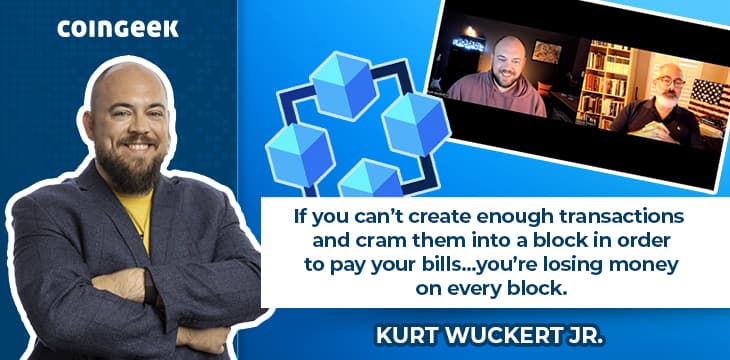|
Getting your Trinity Audio player ready...
|
Kurt Wuckert Jr. appeared on the Messy Times podcast for a second round of discussion about Bitcoin SV, Bitcoin mining, the true potential of a scalable peer-to-peer electronic cash system, and much more.
An explanation of mining and some myths about Bitcoin
Podcast host Christopher Messina opens with a quote by Wuckert:
Hashing for subsidies has been extremely profitable, and the continual arms race in hashing has led to levels of efficiency that were frankly unfathomable to the Bitcoin economy just a decade ago, but there is zero readiness to function in a world with quantitative tightening and the very low emission rate of the Bitcoin block subsidy.
Messina says that this quote is just “words” to him and asks Wuckert to explain it in non-technical terms.
Wuckert begins by dispelling a common myth that Satoshi Nakamoto created Bitcoin in response to the 2008 financial crisis. “That’s actually not true,” he says, explaining that the white paper came out before people were even sure there would be a full-blown crisis. And that the housing bubble bursting only became apparent in early 2009, at which point Bitcoin had “tens of thousands of lines of code” already.
Wuckert believes that a lot of the monetary activism of early Bitcoiners is projected onto Satoshi. He points out that Bitcoin was one manifestation of a currency that cypherpunk types had been looking for going back 30 years (or so they thought) and which Austrian economists like Ludvig von Mises had spoken about a century ago. It’s the combination of this sort of thinking and the timing of Bitcoin’s release that made it “ripe on the vine” but led to many myths and misconceptions about Bitcoin, too. Among these myths is the notion that Bitcoin is deflationary. He also points out that Bitcoin has a fixed supply.
“Nothing about that is deflationary,” Wuckert notes.
It’s this combination of things that gave rise to memes like ‘up only’ and Bitcoin as a store of value, but Wuckert reminds viewers that when we read what Satoshi Nakamoto actually wrote, including both the Bitcoin white paper and his forum posts and emails, it’s clear that Bitcoin was designed for small, casual transactions.
Going back to basics, Wuckert tells Messina how the Bitcoin mining process works and explains how miners are paid a block subsidy and how they distribute coins. This distinction between issuing and distributing coins is crucially important. He reminds us that every 210,000 blocks, this subsidy is cut in half. This process has played out several times already, and miners now receive 6.25 coins per block, and it will continue to work this way, cutting the block reward in half with each new epoch. As well as this, as more miners join the network, the difficulty of solving hash puzzles increases, making the process more competitive.
Wuckert then explains how this process gets exponentially more difficult very quickly as the competition heats up; just a decade ago, blocks could be mined with CPUs, but these days, specialized ASICs are required to even stand a chance of mining a block. The pair briefly discuss how the energy consumption involved here has gotten so huge that it has become a political issue, with Wuckert arguing that Bitcoin mining brings various benefits to the grid, such as load balancing and driving down prices.
Miners as transaction processors
Having explained how the block reward side of Bitcoin mining works, Wuckert then explains that miners get paid for one other thing; processing transactions. This is not something the ASICs do, he says, telling Messina that this part is built into the node server structure. “This is where the fun math stuff happens,” he says. The calculations that take place here include whether a person has the balance they want to spend, whether it’s being sent to a valid address, whether they sent too much (in which case the change would be returned), and a few other things.
Of course, miners earn fees for processing these transactions. Wuckert explains how GorillaPool, a mining operation in which he is a partner, charges 0.05 satoshis per byte right now. This fee-per-transaction model is the big-blocker thesis in a nutshell; when there’s no subsidy left, they’ll still be able to earn a profit by processing vast numbers of transactions.
At this point, Wuckert tells Messina that BTC has limited the block sizes to 1MB.
“If you can’t create enough transactions and cram them into a block in order to pay your bills…you’re losing money on every block,” he explains.
How will BTC deal with this self-created issue? Wuckert says those at the top know it’s an issue, and the conversation revolves around either adding a permanent tail emission of inflation or increasing the block size.
However, the latter option is a problem because many people involved in BTC have staked their careers and reputations vouching for small blocks and viciously attacking anyone who even suggests block size increases. This dilemma/decision is unavoidable unless the value of BTC keeps doubling every cycle forever or transaction fees can go up forever priced in dollars. Wuckert sees both of these options as unreasonable, and he predicts that at some point, a BTC civil war will break out over this issue.
The most important thing about Bitcoin
Wuckert believes that the most important thing about Bitcoin is its ability to free up and facilitate entrepreneurship in the developing world, and he tells Messina exactly this.
“There are 3.5 billion people, right now, that don’t have access to the global economy,” Wuckert says, wondering how many of them are potentially great inventors like Nikola Tesla or great business people like John D. Rockefeller. He believes that if you give these people the chance to compete on a level playing field like Bitcoin, the spillover benefits would be priceless. He encourages viewers to think about what we could be building and who we could be liberating, but instead, it’s “all nonsense,” with 20,000 digital currencies being gambled on in bucket shops like Binance. Messina agrees, pointing out that apps like Robinhood have gamified the process of buying even more traditional assets like stocks, and he wonders how regulators have allowed it to continue for so long.
Wuckert also points out some of the benefits of an immutable global ledger, noting that if you run a scam on Bitcoin, there’ll be a permanent record of it. He notes that it might take law enforcement a while to figure it out, years even, but the odds are they will figure it out eventually.
Touching briefly on other blockchains, Wuckert tells Messina they “don’t even work.” He dismisses hype like Ethereum 2.0, stating that it has been touted for years and never arrived. He points out that while BSV as an asset has remained flat for a few years, the blockchain continues to get more efficient. He likens Bitcoin’s growth to the internet, pointing out that if and when the company comes along that needs one billion transactions per second, there’s only one game in town—Bitcoin SV.
Watch the BSV Global Blockchain Convention Dubai 2022 Day 1 here:
https://youtu.be/ggbZ8YedpBE
Watch the BSV Global Blockchain Convention Dubai 2022 Day 2 here:
https://youtu.be/RzJsCRb6zt8
Watch the BSV Global Blockchain Convention Dubai 2022 Day 3 here:
https://youtu.be/RzSCrXf1Ywc

 12-24-2025
12-24-2025 




